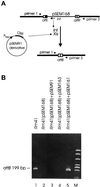Identification of site-specific recombination genes int and xis of the Rhizobium temperate phage 16-3
- PMID: 10400574
- PMCID: PMC93918
- DOI: 10.1128/JB.181.14.4185-4192.1999
Identification of site-specific recombination genes int and xis of the Rhizobium temperate phage 16-3
Abstract
Phage 16-3 is a temperate phage of Rhizobium meliloti 41 which integrates its genome with high efficiency into the host chromosome by site-specific recombination through DNA sequences of attB and attP. Here we report the identification of two phage-encoded genes required for recombinations at these sites: int (phage integration) and xis (prophage excision). We concluded that Int protein of phage 16-3 belongs to the integrase family of tyrosine recombinases. Despite similarities to the cognate systems of the lambdoid phages, the 16-3 int xis att system is not active in Escherichia coli, probably due to requirements for host factors that differ in Rhizobium meliloti and E. coli. The application of the 16-3 site-specific recombination system in biotechnology is discussed.
Figures






Similar articles
-
Site-specific recombination of temperate Myxococcus xanthus phage Mx8: regulation of integrase activity by reversible, covalent modification.J Bacteriol. 1999 Jul;181(13):4062-70. doi: 10.1128/JB.181.13.4062-4070.1999. J Bacteriol. 1999. PMID: 10383975 Free PMC article.
-
Genome Integration and Excision by a New Streptomyces Bacteriophage, ϕJoe.Appl Environ Microbiol. 2017 Feb 15;83(5):e02767-16. doi: 10.1128/AEM.02767-16. Print 2017 Mar 1. Appl Environ Microbiol. 2017. PMID: 28003200 Free PMC article.
-
Characterization of the genes encoding integrative and excisive functions of Lactobacillus phage øg1e: cloning, sequence analysis, and expression in Escherichia coli.Gene. 1997 Jan 31;185(1):119-25. doi: 10.1016/s0378-1119(96)00648-8. Gene. 1997. PMID: 9034322
-
Site-specific recombination by phiC31 integrase and other large serine recombinases.Biochem Soc Trans. 2010 Apr;38(2):388-94. doi: 10.1042/BST0380388. Biochem Soc Trans. 2010. PMID: 20298189 Review.
-
Phage-encoded Serine Integrases and Other Large Serine Recombinases.Microbiol Spectr. 2015 Aug;3(4). doi: 10.1128/microbiolspec.MDNA3-0059-2014. Microbiol Spectr. 2015. PMID: 26350324 Review.
Cited by
-
Ribonucleotide reductase genes of Bacillus prophages: a refuge to introns and intein coding sequences.Nucleic Acids Res. 2001 Aug 1;29(15):3212-8. doi: 10.1093/nar/29.15.3212. Nucleic Acids Res. 2001. PMID: 11470879 Free PMC article.
-
Identification of an Integrase That Responsible for Precise Integration and Excision of Riemerella anatipestifer Genomic Island.Front Microbiol. 2019 Sep 20;10:2099. doi: 10.3389/fmicb.2019.02099. eCollection 2019. Front Microbiol. 2019. PMID: 31616389 Free PMC article.
-
Site-specific integrative elements of rhizobiophage 16-3 can integrate into proline tRNA (CGG) genes in different bacterial genera.J Bacteriol. 2002 Jan;184(1):177-82. doi: 10.1128/JB.184.1.177-182.2002. J Bacteriol. 2002. PMID: 11741858 Free PMC article.
-
New evidence supports the prophage origin of RcGTA.Appl Environ Microbiol. 2024 Sep 18;90(9):e0043424. doi: 10.1128/aem.00434-24. Epub 2024 Aug 27. Appl Environ Microbiol. 2024. PMID: 39189727 Free PMC article.
-
Identification of cohesive ends and genes encoding the terminase of phage 16-3.J Bacteriol. 2005 Apr;187(7):2526-31. doi: 10.1128/JB.187.7.2526-2531.2005. J Bacteriol. 2005. PMID: 15774897 Free PMC article.
References
-
- Abremski K E, Hoess R H. Evidence for a second conserved arginine residue in the integrase family of recombination proteins. Protein Eng. 1992;5:87–91. - PubMed
-
- Altschul S F, Gish W, Miller W, Myers E W, Lipman D J. Basic local alignment search tool. J Mol Biol. 1990;215:403–410. - PubMed
-
- Berman M L, Enquist L W, Silhavy T J, editors. Advenced bacterial genetics. Cold Spring Harbor, N.Y: Cold Spring Harbor Laboratory; 1982. p. 132.
Publication types
MeSH terms
Substances
Associated data
- Actions
LinkOut - more resources
Full Text Sources

